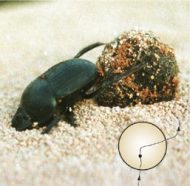Navigating by the light of the moon
A dung beetle is the first animal found to navigate by detecting a property of moonlight.
By Emily Sohn
Moonlight inspires poetry, love songs, and, it seems, even dung beetles.
Nighttime experiments have shown that dung beetles use a property of moonlight known as polarization to keep themselves moving in a straight line.

Other experiments have shown that certain insects use polarization patterns of sunlight to orient themselves in the daytime. Fish and birds might be able to do the same thing. But this is the first example of any animal using light from the moon in this way.
African dung beetles (Scarabaeus zambesianus) often attack a pile of elephant dung by the dozens. Each beetle grabs a small chunk of waste, then rolls it away.
The beetles eat the waste. And males use extra-large balls of it to attract mates. With food and family at stake, dung piles are often the site of wrestling matches between competing beetles, as one male tries to grab another’s precious ball. Being able to navigate in a straight line is an important skill for the beetles because it helps them escape the madness as quickly as possible.
Scientists from Sweden and South Africa noticed that one species of African dung beetle works especially late when the moon is out. To figure out how the beetles find their way, the researchers set out a pile of pig poop on moonlit nights. Within minutes, dung beetles showed up.
Then, the researchers used special filters to rotate the moonlight’s direction of polarization by 90 degrees. All the beetles shifted course by 90 degrees, too. When the beetles crawled out from under the filter, they turned back to their original course.
It’s worth admiring the dung beetle’s ability to use polarization patterns in moonlight to orient themselves. As for people, poetry is probably the best we’ll ever do.







